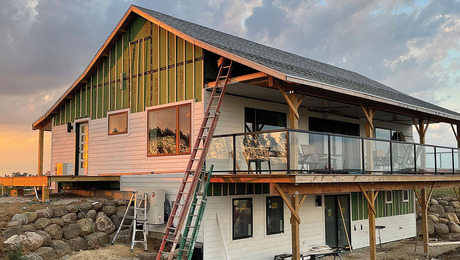Double sided shear wall question
I’m remodeling a 2×6 gable end wall that is 18′ x 25′ with a lot of windows. An engineer friend has given me a rough sketch of all the extra blocking and strapping that will be required. It’s fairly elaborate to say the least since the windows come within 3′ of the corners and the wall is not ballooned framed. I was wondering if it might just be easier to shear wall the interior. If I do, is it common practice to just drywall over the 1/2″ shear or can I just put a knockdown finish right on the plywood. Are there any other issues to be aware of other than getting extra width on my jamb extensions and mounting my electrical boxes out further? Thanks















Replies
Tomski,
Just a few thoughts: You definitely need drywall over the shear ply, and the wiring may be out of sequence in that wall, since wire and boxes gotta go in there before you close the inside. Nail plates or a map are critical unless the nails are short enough to miss the centered holes. The adjustable boxes are great for this application.
Bill
Thanks Bill,
Good thoughts on the map to show where the wires are!
Tom
Consider using EMT for the double sided wall. That way you can pull wire in if you need to make changes.
-- J.S.
Thanks for the input everyone. Wouldn't have thought about the wire issues.
The last custom I built had double shearwalls on all exterior walls and all interior bearing walls along with heavy strapping, foundation to top-of-second-story wall top plate seismic tie downs (major overkill in my opinion, but the engineer God had spec'd it and the State Building Codes Division had blessed it, so it came to pass that I built it).
So, your biggest issues are what you've identified; custom jams or jam extensions, extended electrical boxes. We also had a central vac system and required extensions on all the ports that were located in the shear walls.
Now, I've seen plywood skim coated in a couple situations in small rooms that seemed to perform OK, but both were in Eastern Oregon high desert country which is quite arid with minimal humidity swings. I would not attempt it in my area which is maritime PNW where relative humidity can vary several percentage points in the course of a few days and a wood substrate is going to have some movement....not a good condition for a typical drywall mud.
So, adding the drywall to the plywood would certainly be my choice. And it's pretty easy to glue/screw it to a plywood backer and you can even drop down to 3/8" if you desire.
If there is a benefit to all those thicker walls it is, IMO, the attractive appearance of the deeper sills and jams in the finished structure.
As Bill said, get all your ducks in a row, since it's very hard to pull new wires or whatnot once it's closed up. Absolutely use sheetrock.
Usually when we're sheathing the interior of a wall its for a hunter to hang mounts on the wall, but I am a big believer in the advantages it provides for firming up a wall for any number of structural reasons.
My "trick" on some of the old houses in our area that had 2nd-floor bays added over porches that tend to droop, is to skin each internal facet with full sheets (or laminated built-up sheets) of ply, from corner to corner with the window RO cut out.
Then I open up galv DW corner bead, and screw it through the edges of the ply into the studs up the vertical interior off-angles between each facet and the base walls.
Then make 9/16 jamb extensions and DW as normal. Otherwise, you always get cracks at window / door corners and up the off-angles.
Forrest
Edited 5/9/2006 7:19 am by McDesign